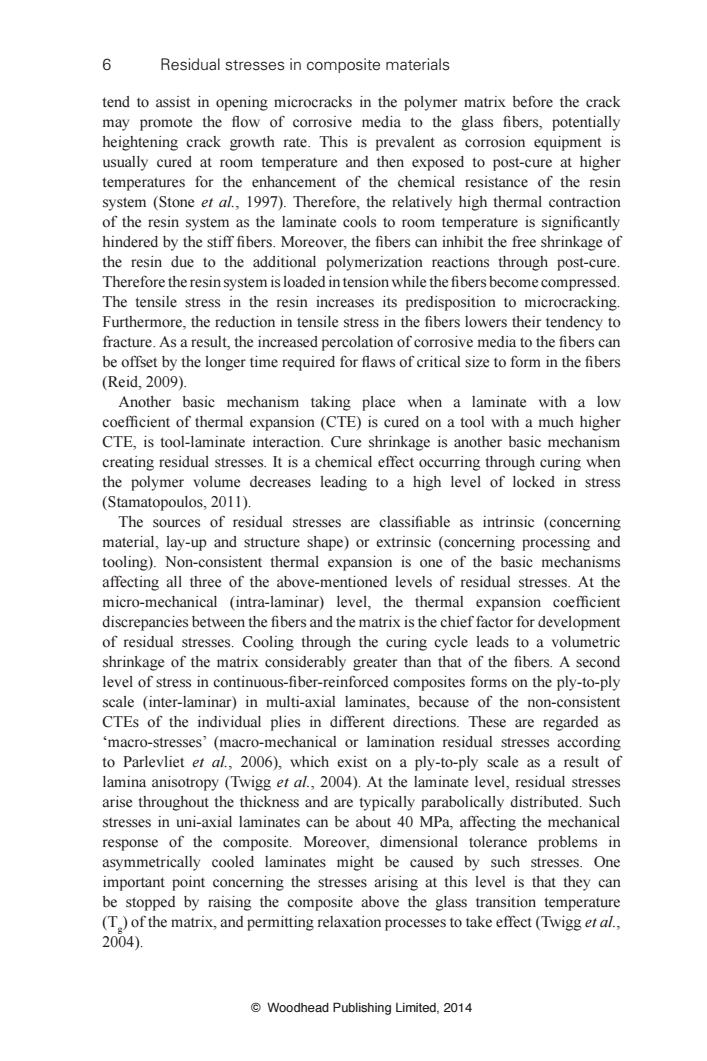正在加载图片...

6 Residual stresses in composite materials tend to assist in opening microcracks in the polymer matrix before the crack may promote the flow of corrosive media to the glass fibers,potentially heightening crack growth rate.This is prevalent as corrosion equipment is usually cured at room temperature and then exposed to post-cure at higher temperatures for the enhancement of the chemical resistance of the resin system (Stone et al.,1997).Therefore,the relatively high thermal contraction of the resin system as the laminate cools to room temperature is significantly hindered by the stiff fibers.Moreover,the fibers can inhibit the free shrinkage of the resin due to the additional polymerization reactions through post-cure. Therefore the resin system is loaded in tension while the fibers become compressed. The tensile stress in the resin increases its predisposition to microcracking Furthermore,the reduction in tensile stress in the fibers lowers their tendency to fracture.As a result,the increased percolation of corrosive media to the fibers can be offset by the longer time required for flaws of critical size to form in the fibers (Reid,2009). Another basic mechanism taking place when a laminate with a low coefficient of thermal expansion(CTE)is cured on a tool with a much higher CTE,is tool-laminate interaction.Cure shrinkage is another basic mechanism creating residual stresses.It is a chemical effect occurring through curing when the polymer volume decreases leading to a high level of locked in stress (Stamatopoulos,2011). The sources of residual stresses are classifiable as intrinsic (concerning material,lay-up and structure shape)or extrinsic (concerning processing and tooling).Non-consistent thermal expansion is one of the basic mechanisms affecting all three of the above-mentioned levels of residual stresses.At the micro-mechanical (intra-laminar)level,the thermal expansion coefficient discrepancies between the fibers and the matrix is the chief factor for development of residual stresses.Cooling through the curing cycle leads to a volumetric shrinkage of the matrix considerably greater than that of the fibers.A second level of stress in continuous-fiber-reinforced composites forms on the ply-to-ply scale (inter-laminar)in multi-axial laminates,because of the non-consistent CTEs of the individual plies in different directions.These are regarded as 'macro-stresses'(macro-mechanical or lamination residual stresses according to Parlevliet et al.,2006),which exist on a ply-to-ply scale as a result of lamina anisotropy (Twigg et al.,2004).At the laminate level,residual stresses arise throughout the thickness and are typically parabolically distributed.Such stresses in uni-axial laminates can be about 40 MPa,affecting the mechanical response of the composite.Moreover,dimensional tolerance problems in asymmetrically cooled laminates might be caused by such stresses.One important point concerning the stresses arising at this level is that they can be stopped by raising the composite above the glass transition temperature (T)of the matrix,and permitting relaxation processes to take effect (Twigg et al., 2004). Woodhead Publishing Limited,20146 Residual stresses in composite materials © Woodhead Publishing Limited, 2014 tend to assist in opening microcracks in the polymer matrix before the crack may promote the fl ow of corrosive media to the glass fi bers, potentially heightening crack growth rate. This is prevalent as corrosion equipment is usually cured at room temperature and then exposed to post- cure at higher temperatures for the enhancement of the chemical resistance of the resin system (Stone et al. , 1997). Therefore, the relatively high thermal contraction of the resin system as the laminate cools to room temperature is signifi cantly hindered by the stiff fi bers. Moreover, the fi bers can inhibit the free shrinkage of the resin due to the additional polymerization reactions through post- cure. Therefore the resin system is loaded in tension while the fi bers become compressed. The tensile stress in the resin increases its predisposition to microcracking. Furthermore, the reduction in tensile stress in the fi bers lowers their tendency to fracture. As a result, the increased percolation of corrosive media to the fi bers can be offset by the longer time required for fl aws of critical size to form in the fi bers (Reid, 2009). Another basic mechanism taking place when a laminate with a low coeffi cient of thermal expansion (CTE) is cured on a tool with a much higher CTE, is tool- laminate interaction. Cure shrinkage is another basic mechanism creating residual stresses. It is a chemical effect occurring through curing when the polymer volume decreases leading to a high level of locked in stress (Stamatopoulos, 2011). The sources of residual stresses are classifi able as intrinsic (concerning material, lay- up and structure shape) or extrinsic (concerning processing and tooling). Non- consistent thermal expansion is one of the basic mechanisms affecting all three of the above- mentioned levels of residual stresses. At the micro- mechanical (intra- laminar) level, the thermal expansion coeffi cient discrepancies between the fi bers and the matrix is the chief factor for development of residual stresses. Cooling through the curing cycle leads to a volumetric shrinkage of the matrix considerably greater than that of the fi bers. A second level of stress in continuous- fi ber-reinforced composites forms on the ply- to-ply scale (inter- laminar) in multi- axial laminates, because of the non- consistent CTEs of the individual plies in different directions. These are regarded as ‘macro- stresses’ (macro- mechanical or lamination residual stresses according to Parlevliet et al. , 2006), which exist on a ply- to-ply scale as a result of lamina anisotropy (Twigg et al. , 2004). At the laminate level, residual stresses arise throughout the thickness and are typically parabolically distributed. Such stresses in uni- axial laminates can be about 40 MPa, affecting the mechanical response of the composite. Moreover, dimensional tolerance problems in asymmetrically cooled laminates might be caused by such stresses. One important point concerning the stresses arising at this level is that they can be stopped by raising the composite above the glass transition temperature (T g ) of the matrix, and permitting relaxation processes to take effect (Twigg et al. , 2004)